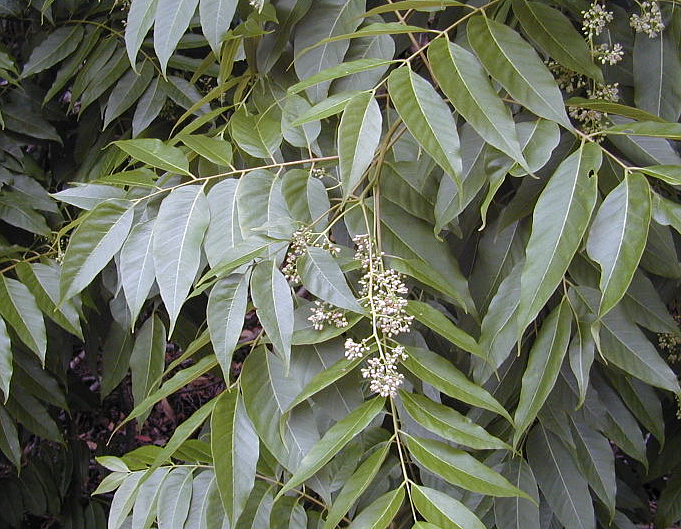

Zitierweise / cite as:
Carakasaṃhitā: Ausgewählte Texte aus der Carakasaṃhitā / übersetzt und erläutert von Alois Payer <1944 - >. -- Anhang A: Pflanzenbeschreibungen. -- Toona ciliata M. Roem. -- Fassung vom 2007-07-27. -- URL: http://www.payer.de/ayurveda/pflanzen/toona_ciliata.htm
Erstmals publiziert: 2007-07-27
Überarbeitungen:
Anlass: Lehrveranstaltung SS 2007
©opyright: Dieser Text steht der Allgemeinheit zur Verfügung. Eine Verwertung in Publikationen, die über übliche Zitate hinausgeht, bedarf der ausdrücklichen Genehmigung des Verfassers
Dieser Text ist Teil der Abteilung Sanskrit von Tüpfli's Global Village Library
WARNUNG: dies ist der Versuch einer
Übersetzung und Interpretation eines altindischen Textes. Es ist keine
medizinische Anleitung. Vor dem Gebrauch aller hier genannten Heilmittel wird
darum ausdrücklich gewarnt. Nur ein erfahrener, gut ausgebildeter ayurvedischer
Arzt kann Verschreibungen und Behandlungen machen!
Falls Sie die diakritischen Zeichen nicht dargestellt bekommen, installieren Sie eine Schrift mit Diakritika wie z.B. Tahoma.
Verwendete und zitierte Werke siehe: http://www.payer.de/ayurveda/caraka0001.htm

Abb.: Toona ciliata M. Roem. = Surenbaum
[Bildquelle: Wikipedia]
Drury:
"Cedrela toona (Roxb.) N. O. Cedrelaceae. Indian Mahogany, White Cedar, Eng. Toon-marum, Tam. Toona, Hind. Toon, Beng.
Description.—Tree, 60 feet; leaves abruptly pinnate; leaflets 6-12 pairs, ovate-lanceolate, acuminated, slightly undulated on the margins, quite entire or slightly and distinctly toothed, glabrous; calyx small, 5-cleft; petals 5, ciliated; panicles drooping, terminal; capsule oblong, 5-celled; dehiscent ; flowers small, white, fragrant. Fl. May—June.— W. & A. Prod. i 124.—Roxb. Fl. Ind. i. 635.—Corom, iii. t. 238.—Wight Icon. t. 161.-------Peninsula. Bengal.
Medical Uses.—The bark is powerfully astringent, and has been found a good remedy in remittent and intermittent fevers, diarrhoea, and dysentery, and, though not bitter, is a fair substitute for Peruvian bark, particularly when united with powdered Bonduc nut Powdered and applied externally it has been beneficially used in
the treatment of ulcers. Rumphius states that an infusion of this bark in combination with the root of the Acorus calamus (Vuseamboo) is given in Java in fevers and other complaints. Forster considered it especially useful in bilious fevers and inveterate diarrhoea arising from atony of the muscular fibre.—Ainslie.
Economic Uses.—The wood of this tree is very like mahogany, but lighter, and not so close in the grain. It is much used for furniture and various other purposes. It is usually found in dry deciduous forests up to 4000 feet elevation. It is called Suli and Mali in the Salem district, Kal Killingi on the Neilgherry slopes, and Sandaru Vembu in Tinnevelly. It is often used as an avenue tree, especially in the Salem district, as it grows readily from seed, In Assam excellent boats are made from it. Nees von Esonbeck analysed the bark, which indicated the existence of a resinous astringent matter, a brown astringent gum, and a gummy brown extractive matter resembling ulmine. The flowers are used in Mysore for dyeing cotton a beautiful red.—(Roxb. Bedd. Fl. Sylv. t. 10.) The wood is dense, red, hard, close-grained, capable of high polish, not subjected to worms, nor liable to warp, and durable.— Powells Punj. Prod."
[Quelle: Drury, Heber <1819 - 1872>: The useful plants of India : with notices of their chief value in commerce, medicine, and the arts. -- 2d ed. with additions and corrections. London : Allen, 1873. -- xvi, 512 p. ; 22 cm. -- s.v.]